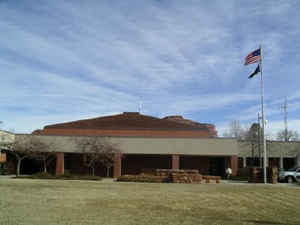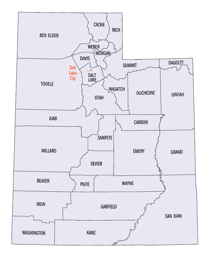Utah Counties
There are twenty-nine counties in the State of Utah. There were originally seven counties established under the provisional State of Deseret in 1849: Davis, Iron, Sanpete, Salt Lake, Tooele, Utah, and Weber. The Territory of Utah was created in 1851 with the first territorial legislature meeting from 1851-1852. The first legislature re-created the original counties from the State of Deseret under territorial law as well as establishing three additional counties: Juab, Millard, and Washington. All other counties were established between 1854 and 1894 by the Utah Territorial Legislature under territorial law except for the last two counties formed, Daggett and Duchesne.Kane County, Utah
Kane County Education, Geography, and History

Kane County is a county located in the state of Utah. Based on the 2010 census, the population was 7,125. Its county seat and largest city is Kanab. The county was named for Col. Thomas L. Kane, a friend of the Mormon settlers.
Etymology - Origin of Kane County Name
The county was named for Col. Thomas L. Kane, a friend of the Mormon settlers.
Demographics:
County QuickFacts: CensusBureau Quick Facts
Kane County History
The high desert landscape of Kane County belongs to the Colorado Plateau geographical province. The waters of man-made Lake Powell on the Colorado River form the county's eastern border, and most of the streams in Kane are part of the Colorado River system. The northwest corner of the county is forested.The county's prehistoric Indian dwellers were part of the Anasazi Culture. Archaeologists have recorded hundreds of sites on Fifty Mile Mountain within the Glen Canyon National Recreation Area, but few have been excavated because of their remoteness. The Southern Paiutes occupied the county in historic times.
Several towns, including Kanab, were first settled in the mid-1860s and then abandoned. Kanab was resettled in 1870 by Levi Stewart and others at the request of Brigham Young. In March 1874 Young encouraged the formation of a United Order at Orderville. Although United Orders were organized in many Utah towns, including Kanab, the Orderville experiment in communal living was more successful and longer-lived, making this town unique among Utah settlements. By the 1880s Mormon church support had become lukewarm, and the United Order of Orderville was dissolved.
During the 19th and early 20th centuries a majority of the county's residents were farmers or ranchers. In 1922 when Deadwood Coach with Tom Mix was filmed in Kane County, the Parry brothers of Kanab led in the development of lodging, food, and other services for film crews, and by the 1930s Kanab was called Little Hollywood because so many movies were made there. The 1920s and 1930s also saw Kanab become a tourist center for visitors to Bryce Canyon, Zion, and Grand Canyon National Parks. During the construction of Glen Canyon Dam near Page, Arizona, which began in 1956, Kanab's population doubled and the economy boomed. The creation of Lake Powell, one of Utah's major recreational sites, brought new service industries connected with boating and fishing to the area, especially the Bullfrog Basin Marina in the extreme northeast corner of the county.
Enormous coal reserves in the Kaiparowits Plateau and Alton fields are Kane County's most important natural resource and may, when environmental issues are resolved, dictate a new economic future based on mining.
*Sources: Beehive History 14: Utah Counties. 1988. Utah State Historical Society, 300 Rio Grande, Salt Lake City, UT 84101-1182.
Geography: Land and Water
As reported by the Census Bureau, the county has a total area of 4,108 square miles (10,641 km2), of
which, 3,992 square miles (10,339 km2) of it is land and 116 square miles (302 km2) of it (2.83%) is water. The
Colorado River, reformed as Lake Powell, forms its eastern boundary. Arizona lies on the southern boundary.
Grand Staircase-Escalante National Monument covers much of the county. A rugged and inhospitable country of
deserts, mountains and cliffs makes up the terrain, with breath-taking scenery in every area. Parts of Bryce
Canyon National Park and Zion National Park extend into the northern and western portions of the county. The
eastern part of the county is comprised of part of the Glen Canyon National Recreation Area.
Neighboring Counties
Bordering counties are as follows:
- Washington County, Utah - (west)
- Iron County, Utah - (northwest)
- Garfield County, Utah - (north)
- San Juan County, Utah - (east)
- Mohave County, Arizona - (southwest)
- Coconino County, Arizona - (south)
Education







